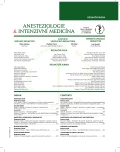Echocardiography in the acute coronary syndrome
Authors:
M. Pořízka
Authors‘ workplace:
Klinika anesteziologie, resuscitace a intenzivní medicíny, 1. lékařská fakulta, Univerzita Karlova v Praze
a Všeobecná fakultní nemocnice v Praze
Published in:
Anest. intenziv. Med., 27, 2016, č. 5, s. 309-314
Category:
Overview
Echocardiography is a non-invasive diagnostic technique that provides information regarding heart function and haemodynamics. It is essential both for diagnosing the acute coronary syndrome, evaluation of the ventricular function and the presence of regional wall motion abnormalities, and for ruling out other etiologies of acute chest pain or dyspnoea. It also provides timely and accurate diagnosis in the haemodynamically unstable patients presenting with myocardial infarction complications including cardiac tamponade, severe mitral regurgitation or ventricular septal defect. This review focuses on the current role of echocardiography in patients with the acute coronary syndrome and its complications.
KEYWORDS:
echocardiography – acute coronary syndrome – myocardial infarction – heart failure
Sources
1. Flachskampf, F. et al. Cardiac imaging after myocardial infarction. European Heart Journal, 2011, 32, p. 272–283.
2. Antman, E. et al. 2007 focused update of the ACC/AHA 2004 Guidelines for the Management of Patients With ST-Elevation Myocardial Infarction: a report of the American College of Cardiology/American Heart Association Task Force on Practice Guidelines (Writing Group to Review New Evidence and Update the ACC/AHA 2004 Guidelines for the Management of Patients With ST-Elevation Myocardial Infarction). J. Am. Coll. Cardiol., 2008, 51, p. 210–247.
3. Kontos, M. et al. Early echocardiography can predict cardiac events in emergency department patients with chest pain. Ann. Emerg. Med., 1998, 31, p. 550–557.
4. Cerqueira, M. et al. Standardized myocardial segmentation and nomenclature for tomographic imaging of the heart. Circulation, 2002, 105, p. 539–542.
5. Schiller, N. et al. Recommendations for quantitation of the left ventricle by two-dimensional echocardiography. J. Am. Soc. Echocardiogr., 1989, 2, p. 358–367.
6. Picard, M. et al. Natural history of left ventricular size and function after acute myocardial infarction. Assessment and prediction by echocardiographic endocardial surface mapping. Circulation, 1990, 82, p. 484–494.
7. Engstrom, A. et al. Right ventricular dysfunction is an independent predictor for mortality in ST-elevation myocardial infarction patients presenting with cardiogenic shock on admission. Eur. J. Heart Fail., 2010, 12, p. 276–282.
8. Cohn, J. et al. Cardiac remodeling – concepts and clinical implications: a consensus paper from an international forum on cardiac remodeling. On behalf of an international forum on cardiac remodeling. J. Am. Coll. Cardiol., 2000, 35, p. 569–582.
9. Moller, J. et al. Independent prognostic importance of a restrictive left ventricular filling pattern after myocardial infarction: an individual patient meta-analysis: meta-analysis research group in echocardiography acute myocardial infarction. Circulation, 2008, 117, p. 2591–2598.
10. Zotz, R. et al. Diagnosis of papillary muscle rupture after acute myocardial infarction by transthoracic and transesophageal echocardiography. Clin. Cardiol., 1993, 16, p. 665–670.
11. Marwick, T. et al. Ischaemic mitral regurgitation: mechanisms and diagnosis. Heart, 2009, 95, p. 1711–1718.
12. Nakatsuchi, Y. et al. Clinicopathological characterization of cardiac free wall rupture in patients with acute myocardial infarction: difference between early and late phase rupture. Int. J. Cardiol., 1994, 47, p. 33–38.
13. Yeo, T. et al. Clinical profile and outcome in 52 patients with cardiac pseudoaneurysm. Ann. Intern. Med., 1998, 128, p. 299–305.
14. Birnbaum, Y. et al. Ventricular septal rupture after acute myocardial infarction. N. Engl. J. Med., 2002, 347, p. 1426–1432.
15. Kishon, Y. et al. Evolution of echocardiographic modalities in detection of postmyocardial infarction ventricular septal defect and papillary muscle rupture: study of 62 patients. Am. Heart J., 1993, 126, p. 667–675.
16. Delewi, R. et al. Left ventricular thrombus formation after acute myocardial infarction. Heart, 2012, 98, 23, p. 1743–1749.
Labels
Anaesthesiology, Resuscitation and Inten Intensive Care MedicineArticle was published in
Anaesthesiology and Intensive Care Medicine

2016 Issue 5
Most read in this issue
- Hypotension following induction to general anaesthesia: prevalence, significance, risk factors and preventive management options
- The 2016 definition of sepsis (Sepsis-3)
- Selected aspects of anaesthesia for non-obstetric surgical procedures in the pregnant patient
- Body temperature in the anaesthetised child
